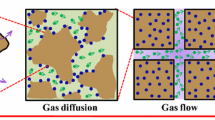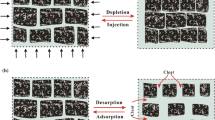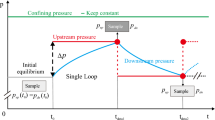Abstract
Gas permeability in coal plays a critical role in predicting coalbed methane (CBM) production. The permeability evolution induced by gas depletion in low-permeability coal is complicated and affected by multi-mechanistic flow components. This study runs a series of permeability tests using the pulse-decay method for helium and CH4, CO2 depletions in coal under both the constant stress boundary (CSB) and uniaxial strain boundary (USB) conditions. With the measured pulse-decay curves, the gas desorption effect on pore pressure depletion can be clearly noticed and gas permeability change can be estimated. The result shows that the helium permeability under the CSB condition is slightly lower than that under the USB condition, and it decays nonlinearly with pressure drawdown and does not rebound in the low-pressure region, which indicates that the helium permeability evolution is mainly controlled by the effective stress in the tested coal. For the sorbing gas CH4/CO2, the permeability profile under the two boundary conditions behaves somewhat similarly; it initially declines with the pressure depletion and then starts to rebound in low-pressure region. The permeability ‘rebound’ of CH4 is comparatively less than that of CO2 due to the larger adsorption capacity of CO2 in coal. With the comparison of permeability behaviors of the different test fluids, it is inferred that the sorbing gas permeability ‘rebound’ should be mainly caused by the matrix shrinkage. The result of this study reveals that coal reservoirs produce CBM using a multi-mechanism approach, and the effect of matrix flows on the permeability behavior and the overall CBM production should be highly emphasized.









Similar content being viewed by others
References
Brace, W., Walsh, J., Frangos, W.: Permeability of granite under high pressure. J Geophys Res 73(6), 2225–2236 (1968)
Chen, Z., Liu, J., Pan, Z., et al.: Influence of the efficient and sorption-induced strain on the evolution of coal permeability: model development and analysis. Int J Green Gas Con 8, 101–110 (2012)
Chen, D., Pan, Z., Shi, J., et al.: A novel approach for modeling coal permeability during transition from elastic to post-failure state using a modified logistic growth function. Int J Coal Geol 163, 132–139 (2016)
Cheng, Y., Pan, Z.: Reservoir properties of Chinese tectonic coal: a review. Fuel 260, 116350 (2020)
Clarkson, C., Nobakht, M., Kaviani, D., et al.: Production analysis of tight gas and shale gas reservoirs using the dynamic-slippage concept. SPE J 17(1), 230–242 (2012)
Connell, L.D.: A new interpretation of the response of coal permeability to changes in pore pressure, stress and matrix shrinkage. Int J Coal Geol 162, 169–182 (2016)
Crosdale, P., Beamish, B., Valix, M.: Coalbed methane sorption related to coal composition. Int J Coal Geol 35, 147–158 (1998)
Cui, X., Bustin, R.: Volumetric strain associated with methane desorption and its impact on coalbed gas production from deep coal seams. AAPG Bull. 89(9), 1181–1202 (2005)
Durucan, S., Edwards, J.: The effects of stress and fracturing on permeability of coal. Mining Sci Technol 3, 205–216 (1986)
Durucan, S., Ahsan, M., Shi, J., et al.: Two phase relative permeabilities for gas and water in selected European coals. Fuel 134, 226–236 (2014)
Fan, L., Liu, S.: Fluid-dependent shear slip behaviors of coal fractures and their implications on fracture frictional strength reduction and permeability evolutions. Int J Coal Geol 212, 103235 (2019)
Fan, J., Liu, P., Li, J., Jiang, D.: A coupled methane/air flow model for coal gas drainage: model development and finite-difference solution. Process Saf Environ Prot 141, 288–304 (2020)
Feng, R., Harpalani, S., Pandey, R.: Laboratory measurement of stress-dependent coal permeability using pulse-decay technique and flow modeling with gas depletion. Fuel 177(1), 76–86 (2016)
Feng, R., Harpalani, S., Pandey, R.: Evaluation of various pulse-decay laboratory permeability measurement techniques for highly stressed coals. Rock Mech Rock Eng 50, 297–308 (2017)
Feng, R., Chen, S., Bryant, S., et al.: Stress-dependent permeability measurement techniques for unconventional gas reservoirs: review, evaluation, and application. Fuel 256, 115987 (2019)
Gray, I.: Reservoir engineering in coal seams: Part 1. The physical process of gas storage and movement in coal seams. SPE Reservoir Eng 2(1), 28–34 (1987)
Harpalani, S., Chen, G.: Influence of gas production induced volumetric strain on permeability of coal. Geotech Geol Eng 15(4), 303–325 (1997)
Harpalani, S., McPherson, M.: Effect of stress on permeability of coal. Q Rev Methane Coal Seams Technol 3, 23–28 (1985)
Harpalani, S., Schraufnagel, R.: Shrinkage of coal matrix with release of gas and its impact on permeability of coal. Fuel 69(5), 551–556 (1990)
Levine, J.: Model study of the influence of matrix shrinkage on absolute permeability of coal bed reservoirs. In: Gayer, R., Harris, I. (eds.) Coalbed methane and coal geology: Geological Society (London), pp. 197–212. Special Publication (1996)
Liu, S.: Estimation of different coal compressibilities of coalbed methane reservoirs under replicated in situ condition. Southern Illinous University Carbondale, USA (2012)
Liu, S., Harpalani, S.: A new theoretical approach to model sorption induced coal shrinkage and swelling. AAPG Bull. 97(7), 1033–1049 (2013)
Liu, S., Harpalani, S.: Evaluation of in situ stress changes with gas depletion of coalbed methane reservoirs. J Geophys Res Solid Earth 119(8), 6263–6276 (2014)
Liu, H., Rutqvist, J.: A new coal-permeability model: internal swelling stress and fracture–matrix interaction. Transp Porous Media 82(1), 157–171 (2010)
Liu, J., Chen, Z., Elsworth, D., et al.: Evaluation of stress-controlled coal swelling processes. Int J Coal Geol 83(4), 446–455 (2010)
Liu, S., Harpalani, S., Pillalamarry, M.: Laboratory measurement and modeling of coal permeability with continued methane production: Part 2 – Modeling results. Fuel 94, 117–124 (2012)
Liu, S., Wang, Y., Harpalani, S.: Anisotropy characteristics of coal shrinkage/swelling and its impact on coal permeability evolution with CO2 injection. Greenhouse Gas Sci Technol 6(5), 615–632 (2016)
Liu, P., Qin, Y., Liu, S., et al.: Non-linear gas desorption and transport behaviors in coal matrix: experiments and numerical modeling. Fuel 214, 1–13 (2018a)
Liu, P., Qin, Y., Liu, S., et al.: Numerical modeling of gas flow in coal using a modified dual-porosity model: a multi-mechanistic approach and finite difference method. Rock Mech Rock Eng 51, 2863–2880 (2018b)
Liu, A., Liu, S., Hou, X., Liu, P.: Transient gas diffusivity evaluation and modeling for methane and helium in coal. Int J Heat Mass Transf 159, 120091 (2020)
Liu, A., Liu, P., Shimin, L.: Gas diffusion coefficient estimation of coal: a dimensionless numerical method and its experimental validation. Int J Heat Mass Transf 162, 120336 (2020b)
Liu, P., Liu, A., Zhong, F., et al.: Pore/fracture structure and gas permeability alterations induced by ultrasound treatment in coal and its application to enhanced coalbed methane recovery. J Petrol Sci Eng 205, 108862 (2021)
Ma, Q., Harpalani, S., Liu, S.: A simplified permeability model for coalbed methane reservoirs based on matchstick strain and constant volume theory. Int J Coal Geol 85, 43–48 (2011)
Mitra, A.: Laboratory investigation of coal permeability under replicated in situ stress regime. Southern Illinois University at Carbondale, Ann Arbor (2010)
Mitra, A., Harpalani, S., Liu, S.: Laboratory measurement and modeling of coal permeability with continued methane production: Part 1–Laboratory results. Fuel 94, 110–116 (2012)
Moore, T.A.: Coalbed methane: a review. Int J Coal Geol 101(101), 36–81 (2012)
Niu, Y., Mostaghimi, P., Shikhov, I., et al.: Coal permeability: gas slippage linked to permeability rebound. Fuel 215, 844–852 (2018)
Palmer, I.: Permeability changes in coal: analytical modeling. Int J Coal Geol 77(1), 119–126 (2009)
Palmer, I.: Coalbed methane completions: a world view. Int J Coal Geol 82(3), 184–195 (2010)
Palmer, I., Mansoori, J.: How permeability depends on stress and pore pressure in coalbeds: a new model. In: SPE annual technical conference and exhibition. Soc Pet Eng 1(06), 539–544 (1996)
Pan, Z., Connell, L.D.: Modelling of anisotropic coal swelling and its impact on permeability behaviour for primary and enhanced coalbed methane recovery. Int J Coal Geol 85, 257–267 (2011)
Pan, Z., Connell, L.D.: Modelling permeability for coal reservoirs: a review of analytical models and testing data. Int J Coal Geol 92, 1–44 (2012)
Pan, Z., Connell, L.D., Camilleri, M.: Laboratory characterisation of coal reservoir permeability for primary and enhanced coalbed methane recovery. Int J Coal Geol 82, 252–261 (2010)
Pekot, L.J., Reeves, S.R.: Modeling the effects of matrix shrinkage and differential swelling on coalbed methane recovery and carbon sequestration. Proceedings of the 2003 International Coalbed Methane Symposium. University of Alabama (2003)
Peng, Y., Liu, J., Pan, Z., et al.: Impact of coal matrix strains on the evolution of permeability. Fuel 189(1), 270–283 (2017)
Perera, M., Ranjith, P., Choi, S., et al.: Investigation of temperature effect on permeability of naturally fractured black coal for carbon dioxide movement: an experimental and numerical study. Fuel 94, 596–605 (2012)
Pillalamarry, M., Harpalani, S., Liu, S.: Gas diffusion behavior of coal and its impact on production from coalbed methane reservoirs. Int J Coal Geol 86, 342–348 (2011)
Pini, R., Ottiger, S., Burlini, L., et al.: Role of adsorption and swelling on the dynamics of gas injection in coal. J Geophys Res Solid Earth 114, B04203 (2009)
Ritter, D., Vinson, D., Barnhart, E., Akob, D., et al.: Enhanced microbial coalbed methane generation: a review of research, commercial activity, and remaining challenges. Int J Coal Geol 146, 28–41 (2015)
Robertson, E.P.: Measurement and modeling of sorption-induced strain and permeability changes in coal. Ph.D. dissertation, Colorado School of Mines, Golden, Colorado (2005)
Sawyer, W.K., Paul, G.W., Schraufnagel, R.A.: Development and application of a 3-D coalbed simulator. In: Annual technical meeting. Petroleum Society of Canada (1990)
Seidle, J.P., Jeansonne, M.W., Erickson, D.J.: Application of matchstick geometry to stress dependent permeability in coals. In: SPE rocky mountain regional meeting. Society of Petroleum Engineers (1992)
Shi, J.Q., Durucan, S.: Drawdown induced changes in permeability of coalbeds: a new interpretation of the reservoir response to primary recovery. Transp Porous Media 56(1), 1–16 (2004)
Shi, J.Q., Durucan, S.: A model for changes in coalbed permeability during primary and enhanced methane recovery. SPE Reservoir Eval. Eng. 8(04), 291–299 (2005)
Wang, Y., Liu, S.: Estimation of pressure-dependent diffusive permeability of coal using methane diffusion coefficient: laboratory measurements and modeling. Energy Fuels 30(11), 8968–8976 (2016)
Wang, G., Ren, T., Wang, K., et al.: Improved apparent permeability models of gas flow in coal with Klinkenberg effect. Fuel 128, 53–61 (2014)
Wang, Y., Liu, S., Elsworth, D.: Laboratory investigations of gas flow behaviors in tight anthracite and evaluation of different pulse-decay methods on permeability estimation. Int J Coal Geol 149, 118–128 (2015)
Wang, Y., Liu, S., Zhao, Y.: Modeling of permeability for ultra-tight coal and shale matrix: a multi-mechanistic flow approach. Fuel 232, 60–70 (2018)
Wu, T., Pan, Z., Connell, L.D., et al.: Apparent gas permeability behavior in the near critical region for real gases. J Nat Gas Sci Egn 77, 103245 (2020)
Yang, Y., Liu, S.: Estimation and modeling of pressure-dependent gas diffusion coefficient for coal: a fractal theory-based approach. Fuel 253, 588–606 (2019)
Zang, J., Ge, Y., Wang, K.: The principal permeability tensor of inclined coalbeds during pore pressure depletion under uniaxial strain conditions: developing a mathematical model, evaluating the influences of featured parameters, and upscaling for CBM recovery. J Nat Gas Sci Egn 74, 103099 (2020)
Zhang, X., Ranjith, P., Perera, M., et al.: Gas transportation and enhanced coalbed methane recovery processes in deep coal seams: a review. Energy Fuels 30, 8832–8849 (2016)
Acknowledgements
This work was supported by the National Key R&D Program of China (No. 2017YFC0804202), National Science and Technology Major Project (2016ZX05045001-005) and Postdoctoral Science Foundation Project Funded by State Key Laboratory of Coal Mine Disaster Dynamics and Control (2011DA105287-BH201901),which are all greatly appreciated.
Author information
Authors and Affiliations
Corresponding author
Additional information
Publisher's Note
Springer Nature remains neutral with regard to jurisdictional claims in published maps and institutional affiliations.
Rights and permissions
About this article
Cite this article
Liu, P., Fan, J. & Jiang, D. Laboratory Measurement of Permeability Evolution Behaviors Induced by Non-Sorbing/Sorbing Gas Depletion in Coal Using Pulse-Decay Method. Transp Porous Med 139, 595–613 (2021). https://doi.org/10.1007/s11242-021-01681-4
Received:
Accepted:
Published:
Issue Date:
DOI: https://doi.org/10.1007/s11242-021-01681-4




